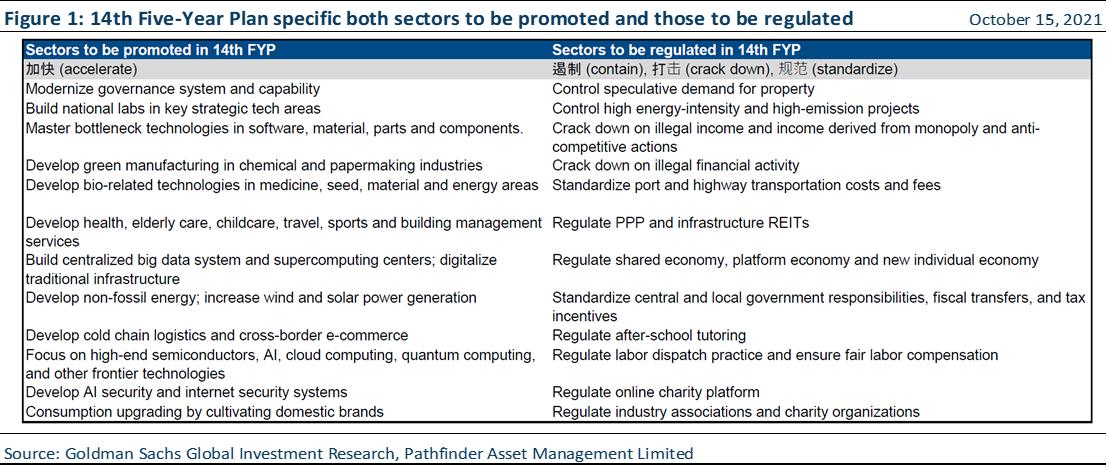Common Prosperity
Regular China watchers will know that there have been some interesting developments with respect to government regulation that have impacted the stock market over there. You may have heard a number of financial pundits declare that China is now “uninvestable”. We thought we would offer our views. The Chinese government has adopted the mantra of “Common Prosperity”, which is an agenda to promote more sustainable and equitable growth by regulating private businesses in certain industries that have become too powerful. The government has said it will pursue “quality growth” rather than “rapid growth”, which means a shift from stimulating growth through infrastructure, real estate, and resource development towards supporting innovation with next generation computer hardware, energy, and environmental technology. The table below was created by Goldman Sachs and concisely captures the goals of the government.

It appears that they will place constraints on profitability in certain industries and attempt to reign in companies that have grown too big or did not engage the government properly. In our view, this is not unlike issues that western governments face. The glaring difference is the forceful nature of the implementation and the lack of traditional messaging that markets are accustom too. Think about the attempts to limit Alphabet, Facebook, Microsoft and AT&T over the years. The goals are somewhat similar. It is just that the abrupt path that the Chinese government has taken has spooked investors.
“This means that” we remain long-term China bulls. The Pathfinder International Fund has a healthy exposure to Chinese companies (32.4% by revenue, 23.9% by listing). While we expect the potential for volatility to continue as investors stretch to understand new regulations and the government evolves its communication style, we believe that China is one of the few areas that currently offers good value with the potential for future growth. We will continue to adjust our exposure to both cheap stocks, and to those special situations that will be promoted by the government.
National Instrument 31-103 requires registered firms to disclose information that a reasonable investor would expect to know, including any material conflicts with the firm or its representatives. Doug Johnson and/or Pathfinder Asset Management Limited are an insider of companies periodically mentioned in this report. Please visit www.paml.ca for full disclosures.
*All returns are time weighted and net of investment management fees. Returns from the Pathfinder Partners’ Fund and Partners’ Real Return Plus Fund are presented based on the masters series of each fund. The Pathfinder Core: Equity Portfolio and The Pathfinder Core: High Income Portfolio are live accounts. These are actual accounts owned by the Pathfinder Chairman (Equity) and client (High Income) which contain no legacy positions, cash flows or other Pathfinder investment mandates or products. Monthly inception dates for each fund and portfolio are as follows: Pathfinder Core: Equity Portfolio (January 2011), Pathfinder Core: High Income Portfolio (October 2012) Partners’ Fund (April 2011), Partners’ Real Return Plus Fund (April, 2013), and Partners’ Core Plus Fund (November 2014).
Pathfinder Asset Management Limited (PAML) and its affiliates may collectively beneficially own in excess of 10% of one or more classes of the issued and outstanding equity securities mentioned in this newsletter. This publication is intended only to convey information. It is not to be construed as an investment guide or as an offer or solicitation of an offer to buy or sell any of the securities mentioned in it. The author has taken all usual and reasonable precautions to determine that the information contained in this publication has been obtained from sources believed to be reliable and that the procedures used to summarize and analyze such information are based on approved practices and principles in the investment industry. However, the market forces underlying investment value are subject to sudden and dramatic changes and data availability varies from one moment to the next. Consequently, neither the author nor PAML can make any warranty as to the accuracy or completeness of information, analysis or views contained in this publication or their usefulness or suitability in any particular circumstance. You should not undertake any investment or portfolio assessment or other transaction on the basis of this publication, but should first consult your portfolio manager, who can assess all relevant particulars of any proposed investment or transaction. PAML and the author accept no liability of any kind whatsoever or any damages or losses incurred by you as a result of reliance upon or use of this publication.